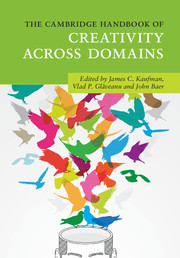Book contents
- The Cambridge Handbook of Creativity Across Domains
- The Cambridge Handbook of Creativity Across Domains
- Copyright page
- Dedication
- Contents
- Figures
- Tables
- Contributors
- Acknowledgments
- Part I Creativity and Domain
- Part II Creativity in the Traditional Arts
- Part III Creativity in the Sciences
- Part IV Creativity in Business
- Part V Newer Domains for Creativity Research
- Part VI Creativity in Everyday Life
- Part VII Conclusion
- 35 Taking a Prospective Look at Creativity Domains
- Index
- References
35 - Taking a Prospective Look at Creativity Domains
from Part VII - Conclusion
Published online by Cambridge University Press: 15 September 2017
- The Cambridge Handbook of Creativity Across Domains
- The Cambridge Handbook of Creativity Across Domains
- Copyright page
- Dedication
- Contents
- Figures
- Tables
- Contributors
- Acknowledgments
- Part I Creativity and Domain
- Part II Creativity in the Traditional Arts
- Part III Creativity in the Sciences
- Part IV Creativity in Business
- Part V Newer Domains for Creativity Research
- Part VI Creativity in Everyday Life
- Part VII Conclusion
- 35 Taking a Prospective Look at Creativity Domains
- Index
- References
Summary
In this concluding chapter we take another look at the complex relationship between generality and specificity with the double aim of: (a) highlighting some of the main lines of argument developed across this Handbook, and (b) looking towards the future, in a prospective manner, to consider the transformation of creative domains, as well as its impact on the generality–specificity debate.
- Type
- Chapter
- Information
- The Cambridge Handbook of Creativity across Domains , pp. 635 - 642Publisher: Cambridge University PressPrint publication year: 2017



